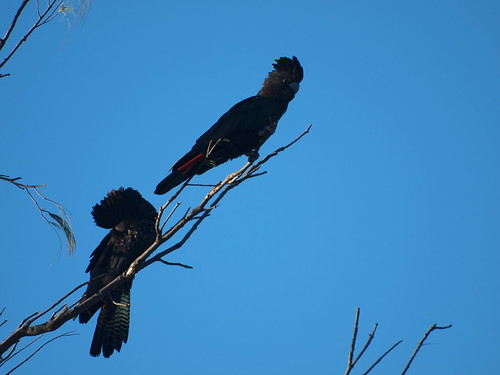Habitat offset policies are not working
 Tuesday, June 15, 2010 at 14:17
Tuesday, June 15, 2010 at 14:17  Habitat offset does not compensate the habitat distruction these Red-tailed Black cockatoos are faceing. Image by MandaUniversity of Queensland researchers are investigating whether habitat offsets could genuinely compensate for the removal of large old trees, the key feeding habitat for the endangered Red-tailed Black-Cockatoo in south-eastern Australia.
Habitat offset does not compensate the habitat distruction these Red-tailed Black cockatoos are faceing. Image by MandaUniversity of Queensland researchers are investigating whether habitat offsets could genuinely compensate for the removal of large old trees, the key feeding habitat for the endangered Red-tailed Black-Cockatoo in south-eastern Australia.
Dr Martine Maron and her colleagues at the School of Geography, Planning and Environmental Management are conducting the research.
Governments are increasingly using ‘habitat offsets' - the process of planting or protecting habitat to compensate for the loss of habitat at a development site - in an attempt to reduce the conflict between continuing development and habitat loss.
But in the case of old-growth trees, the habitat removed cannot be quickly replaced.
Dr Maron's research demonstrates that net loss of habitat over time cannot be avoided, but the impacts of tree removal could be partly compensated for by protecting other trees in the area.
“But this approach was only effective if the protected trees were otherwise very likely to be lost,” Dr Maron said.
“Even when some compensation for habitat loss is possible, there is still a lag period of many decades when the effects of lower habitat availability affects wildlife dependent on large old trees.
“Yet the offset scenarios which did compensate for habitat loss required many trees on otherwise productive agricultural land to be protected for each tree cleared.
"In reality, this is a costly exercise.”
The study demonstrated that although it is possible to use habitat offsets to compensate for habitat loss, typical offset approaches achieve limited environmental compensation.
Dr Maron said that to effectively offset destruction of a mature resource like large trees, replanting efforts must be paired with protection of existing trees which would otherwise decline.
“In some cases, effective offsetting may not be possible, as suitable offsets are rare or too expensive to secure,” she said.
“In those cases, we need to be aware that the impacts of any habitat removal cannot be avoided. When it comes to protecting an endangered species, some habitat is irreplaceable.”

